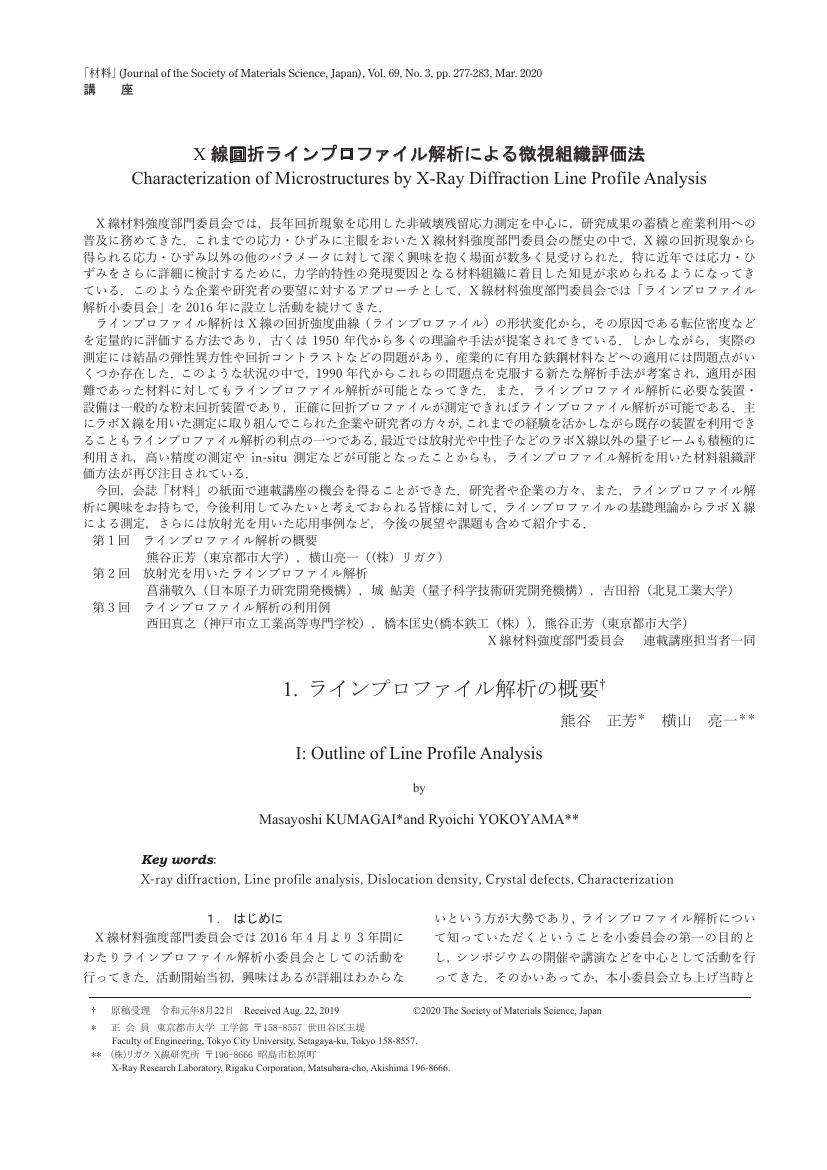3 0 0 0 江戸時代後期に制作された小判ならびに銀判の制作技法の検討
- 著者
- 桐野 文良 大野 直志 田口 智子 根津 暁充 横山 亮一
- 出版者
- 公益社団法人 日本金属学会
- 雑誌
- 日本金属学会誌 (ISSN:00214876)
- 巻号頁・発行日
- 2019
<p>The production processes of old Japanese coins, <i>Genbun-koban</i>, <i>Akita-ginban</i> and <i>Morioka-ginban</i>, were studied. These coins were manufactured by a forging method in the <i>Edo</i>-era. <i>Genbun-koban</i>, manufactured at a gold mint of the <i>Tokugawa</i> shogunate called <i>Kinza</i>, in 1736, is made of Au-Ag alloy and its surface is not flat. The residual stress of this coin is compressive, and the residual stress in the stamped area is higher than that in the flat area. The <i>Iroage</i> method was used to color the coin; it is a thermal treatment, resulting in lows the residual stress is smaller at flat area. <i>Akita-ginban</i>, manufactured in the <i>Akita</i> domain in 1863 is made of pure Ag and its surface is also not flat. There is no residual stress in this coin. This result shows that the thermal treatment of this coin was carried out after processing. <i>Morioka-ginban</i>, manufactured in the <i>Morioka</i> domain in 1868, is made of pure Ag, and its surface is flat. The residual stress of this coin is compressive, and the residual stress in the stamped area is higher than that in the flat area. This result shows that the thermal treatment was not carried out after processing. These coins manufactured in the <i>Edo-</i>era thus had different thermal treatments.</p>
2 0 0 0 OA 江戸時代後期に制作された小判ならびに銀判の制作技法の検討
- 著者
- 桐野 文良 大野 直志 田口 智子 根津 暁充 横山 亮一
- 出版者
- 公益社団法人 日本金属学会
- 雑誌
- 日本金属学会誌 (ISSN:00214876)
- 巻号頁・発行日
- pp.J2018048, (Released:2019-03-01)
- 参考文献数
- 12
The production processes of old Japanese coins, Genbun-koban, Akita-ginban and Morioka-ginban, were studied. These coins were manufactured by a forging method in the Edo-era. Genbun-koban, manufactured at a gold mint of the Tokugawa shogunate called Kinza, in 1736, is made of Au-Ag alloy and its surface is not flat. The residual stress of this coin is compressive, and the residual stress in the stamped area is higher than that in the flat area. The Iroage method was used to color the coin; it is a thermal treatment, resulting in lows the residual stress is smaller at flat area. Akita-ginban, manufactured in the Akita domain in 1863 is made of pure Ag and its surface is also not flat. There is no residual stress in this coin. This result shows that the thermal treatment of this coin was carried out after processing. Morioka-ginban, manufactured in the Morioka domain in 1868, is made of pure Ag, and its surface is flat. The residual stress of this coin is compressive, and the residual stress in the stamped area is higher than that in the flat area. This result shows that the thermal treatment was not carried out after processing. These coins manufactured in the Edo-era thus had different thermal treatments.
1 0 0 0 OA 運動誘発性冠攣縮性狭心症と考えられた1例
- 著者
- 横山 亮 中島 大成 津久田 享三 宇津 典明 宮越 一穂
- 出版者
- 公益財団法人 日本心臓財団
- 雑誌
- 心臓 (ISSN:05864488)
- 巻号頁・発行日
- vol.43, no.11, pp.1484-1487, 2011 (Released:2013-02-05)
- 参考文献数
- 7
- 被引用文献数
- 1
症例は51歳, 男性. 2009年7月ころより安静時, 労作時に胸部圧迫感を認めたため, 当院循環器内科受診. 運動負荷心電図施行中, 胸部症状を認めたため, 試験を中止し, ニトログリセリンを舌下投与したが, 下壁誘導にてST上昇と症状の持続を認めたため, 緊急冠動脈造影検査を施行. 器質的冠動脈狭窄は認めず, 運動誘発性冠攣縮性狭心症と診断した. 入院後, 冠拡張薬内服し安静時, 運動時とも症状は出現しなくなったため, 退院となった. 労作性狭心症の鑑別診断の1つとして留意すべき疾患であると考えられた.
1 0 0 0 OA X線回折ラインプロファイル解析による微視組織評価法 1.ラインプロファイル解析の概要
- 著者
- 熊谷 正芳 横山 亮一
- 出版者
- 公益社団法人 日本材料学会
- 雑誌
- 材料 (ISSN:05145163)
- 巻号頁・発行日
- vol.69, no.3, pp.277-283, 2020-03-15 (Released:2020-03-20)
- 参考文献数
- 40
- 被引用文献数
- 2
1 0 0 0 OA ユーザーの視点からみたシソーラス評価の可能性(特集:インデクシングを考える)
- 著者
- 山崎 久道 高橋 正美 原田 智子 藤田 節子 横山 亮一 吉野 敬子
- 出版者
- 一般社団法人 情報科学技術協会
- 雑誌
- 情報の科学と技術 (ISSN:09133801)
- 巻号頁・発行日
- vol.43, no.9, pp.824-842, 1993-09-01 (Released:2017-05-30)
シソーラスの評価をおもに,利用者の観点から行うための評価基準を開発した。これまでの,評価の試みや作成のガイドラインが,語の取扱いや表示に重点をおいているのに対して,情報源(おもにデータベース)と利用者との結節点としてシソーラスが機能しているかどうかの評価項目に重点をおいた。評価基準は,52項目からなり,1.シソーラスの作成方針と作成方法,2.シソーラスの仕様,3.語および語間の関係,4.シソーラスの表示,の4部分に大別される。評価基準を用いた評価の試行も行った。
- 著者
- 横山 亮一
- 巻号頁・発行日
- 2013
Thesis (Ph. D. in Engineering)--University of Tsukuba, (B), no. 2623, 2013.1.31
